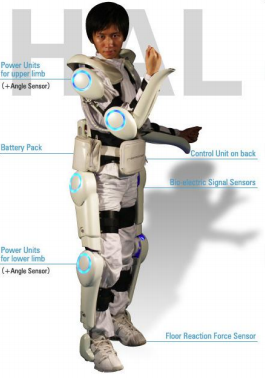The concept of a powered exoskeleton has been with us for a long time.
 The first known example of "powered armour" appeared in the Lensman series of novels
starting in 1937. This concept of an exoskeleton augmenting a human's
physical abilities was made widely popular through the Starship Troopers novel in 1959. As
electronics and
robotics technology was further developed over the years, the once-science-fiction concept slowly became reality.
Today, numerous high-profile exoskeleton development projects are
found throughout the world; ranging in applications from biomedical
assistive devices such as
the Hybrid Assistive Limb (HAL)
developed by University of Tsukuba in Japan, to
the XOS Exoskeleton developed by Sarcos Raytheon
for the U.S. Defense Advanced Research Projects Agency's need for a military powered exoskeleton.
The first known example of "powered armour" appeared in the Lensman series of novels
starting in 1937. This concept of an exoskeleton augmenting a human's
physical abilities was made widely popular through the Starship Troopers novel in 1959. As
electronics and
robotics technology was further developed over the years, the once-science-fiction concept slowly became reality.
Today, numerous high-profile exoskeleton development projects are
found throughout the world; ranging in applications from biomedical
assistive devices such as
the Hybrid Assistive Limb (HAL)
developed by University of Tsukuba in Japan, to
the XOS Exoskeleton developed by Sarcos Raytheon
for the U.S. Defense Advanced Research Projects Agency's need for a military powered exoskeleton.
In addition to from current projects that demonstrate today's technological abilities, the media continues to push boundaries of the imagination out to what future robots and powered exoskeletons can achieve. Some popular examples include Master Chief from the video game series Halo, the Space Marine from the video game StarCraft, as well as Iron Man from the eponymous comic books and movie. All of these examples feature a human with an exoskeleton that augments physical strength; allowing the ability to lift heavy objects and wear protective heavy armour.
 Although there are some technical limitations that limit the
applications that a powered exoskeleton can be used, such as finding a suitable power source while
maintaining portability, a main issue that limits the widespread implementation of
powered exoskeletons is the cost. The HAL is expected to reach a mass production cost of
$12,000—$20,000 USD, which is the price of a small to medium-sized car.
Although there are some technical limitations that limit the
applications that a powered exoskeleton can be used, such as finding a suitable power source while
maintaining portability, a main issue that limits the widespread implementation of
powered exoskeletons is the cost. The HAL is expected to reach a mass production cost of
$12,000—$20,000 USD, which is the price of a small to medium-sized car.
Our project is an exploration of feasibility of lower cost powered exoskeleton. It is our hope the affordability will help promote more widespread use of exoskeletons, and allow more people to reap benefits from today's technology.
Today's high cost prevents adoption in many other fields where exoskeleton technology might otherwise be useful: many more medical applications, safety and rescue, industrial and manufacturing, and hobbies are only a few examples. Lower cost will also enable more casual research and experimentation which might allow for previously unimagined uses for the technology to emerge.
We've decided to focus on building a powered leg exoskeleton to demonstrate the feasibility of the concepts we propose for a larger scale exoskeleton.